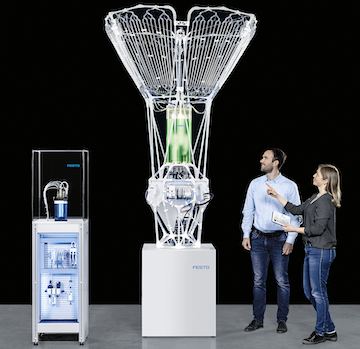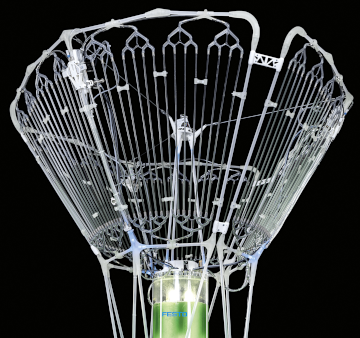
Bionic Algae
By David Gersovitz
Sustainability EnergyFesto automated bioreactor moves algae-based bio-products a step closer to economic viability.

Festo’s automated PhotoBionicCell can bind 100 kg/m2 kilograms of CO2 per square metre and yield 70 tonnes of biomass per year.
(Photo credit: Festo)
That comes with a big “if”. Algae must become cost-competitive with oil and gas. So far, that goal has eluded researchers, but perhaps not for much longer. Highly automated bio-refineries, like a scaled up version of the demonstrator Festo has built, may close or eliminate the gap.
Algae’s potential as a climate change mitigant and component of a sustainable economy is compelling; whereas a square metre of forest can absorb 1-2 kilograms of CO2 annually, and add about 12 tonnes of biomass, Festo’s automated PhotoBionicCell, unveiled at this year’s Hannover Fair, can bind 100 kilograms of CO2 per square metre and yield 70 tonnes of biomass per year. And, since it functions as a closed loop, it also requires dramatically less water to create that biomass.
The PhotoBionicCell’s output capability is a tenfold improvement over growing algae in open basins or foil bioreactors. Automation is the principal reason for that gain, enabling continuous, consistent production around the clock, 365 days a year.
Further optimization of the biology and massive upscaling of the bioreactor concept – employing artificial photosynthesis technology under development – could achieve CO2 absorption rates like 2,000 kg/m2, says Dr. Elias Knubben, Festo’s Vice President Corporate Research and Innovation. But the real attraction is what can be done with that biomass.
Certain species of algae can be processed into a fuel or feedstock for products like bioplastics, foods, cosmetics, pharmaceuticals, dyes, additives and much more. These recyclable products could be produced using green energy, creating a circular economy that keeps nature in balance. In contrast, some 40% of global oil production is currently used to make plastics. About a litre of oil is required to make a typical bottle of shampoo, and about 3 kg of CO2 is released to the atmosphere in the process. Photosynthesis releases oxygen.
But, for such algae-based products to become commercially feasible, “two things have to happen,” Knubben told Festo’s 19th annual International Press Conference (IPC) in July. “On one hand, we have to increase the efficiency of these (algae) growing principles. And oil prices have to increase. Then it will be really effective to produce biofuels from algae economically.”
Using industrial automation to amplify the photosynthetic growth process is one step towards that goal, and Knubben expressed confidence that cost-competitive industrial scale production is years, not decades away. There is still much being done in labs around the world to improve the metabolic process right down to the cellular level. The bioreactor automation can be improved as well.
“We need to understand these processes to optimize the growing conditions,” says Knubben. “It started with the automation of the bioreactor, but it will continue with the development of new software concepts, improving the controls strategies, to be able to move from a laboratory setup to really industrial production.”
With sail-shaped surface collectors, Festo’s PhotoBionicCell looks a bit outer worldly. Algae liquid is pumped upwards into the surface collectors, where it is distributed evenly through transparent acrylic tubing for optimized light absorption and heat exchange before flowing back into the cultivator. The algae’s chloroplast cells photosynthesize light to convert sunlight, CO2 and water into oxygen and chemical energy sources for biofuels and bioproducts. Employing different algae and nutrients in the process can produce biomass with different fatty acids, pigments and surfactants.

Algae liquid is pumped into the PhotoBionicCell’s surface collectors, where it is distributed evenly through transparent acrylic tubing for optimized light absorption and heat exchange before flowing back into the cultivator.
(Photo credit: Festo)
For more than two decades, Festo has been investing in bionics research and innovation, building robotic fauna like birds, fish, spiders and rays, even a kangaroo, that seek to replicate highly efficient movements and group interaction in nature. Some of that acquired knowhow has worked its way into new products like adaptive grippers and advanced controls technology. However, the PhotoBionicCell marks a departure, endeavoring to improve upon nature rather than mimic it.
This 3.0-metre high bioreactor contains a range of the company’s components – a CPX-E automation system, CPE electric terminal, two VEMD proportional flow control valves, six VYKB media-separated solenoid valves, three CMMT-ST motor controllers, a CPX-AP-I bus interface and three CPX-AP-I digital input-output modules.
It also uses the latest automated control and analytical sensor technology to create optimal and consistent growing conditions for 24/7 operation. A holistic gassing concept ensures the carbon dioxide extracted from the ambient air is evenly distributed. If that CO2 isn’t sufficient, more is supplied automatically from a gas cartridge at the base. An innovative ceramic element with minute pores introduces the gas in the form of tiny bubbles. At night, or if there is insufficient daytime sunlight, special UV lamps are used.
To precisely measure the biomass volume, Festo opted for a quantum-technology sensor from Stuttgart start-up Q.ANT. The sensor provides precise, real-time information about the organisms’ growth. Based on the sensor’s output, the algae are fed continuously using Festo microfluidics. The sensor is able to optically detect individual cells so the amount of biomass can be measured. It also can investigate cell vitality, so the processes can be adjusted in a timely manner. Most system analysis is automated; all data is displayed in real time.
Special software was created for dashboards that can display multiple processes or multiple bioreactors on a single display. Artificial Intelligence is used to evaluate data so the bioreactor can be optimized either to propagate the algae cultures or to maintain predefined growth parameters with minimal energy input. It can also be used for predictive maintenance of components.
Scientists are working on developing artificial photosynthesis suitable for growing algae in industrial-scale bioreactors. A promising approach involves so-called droplets – artificial chloroplasts. These have a diameter of around 90 micrometers and are synthetically produced; they contain components of plant organisms, enzymes and biocatalysts. As miniature reaction vessels, they can bind and convert CO2 using light energy far more efficiently than natural photosynthesis.
Still, when industrial grade bio-refineries become economically feasible, others will build them.
“I probably should not say never, but we at Festo will likely never build complete bioreactors, but we intend to continue our development with strategic partners to really scale up in the end,” Festo CEO Dr. Oliver Jung told the IPC’s opening session.
For industrial scale bio-refineries, he said, Festo would like to supply many of the components, from micro-dispensing equipment from its Life Sciences portfolio to valves and valve terminals from its pneumatic automation portfolio to large-diameter valves from its process automation portfolio.
www.festo.ca
